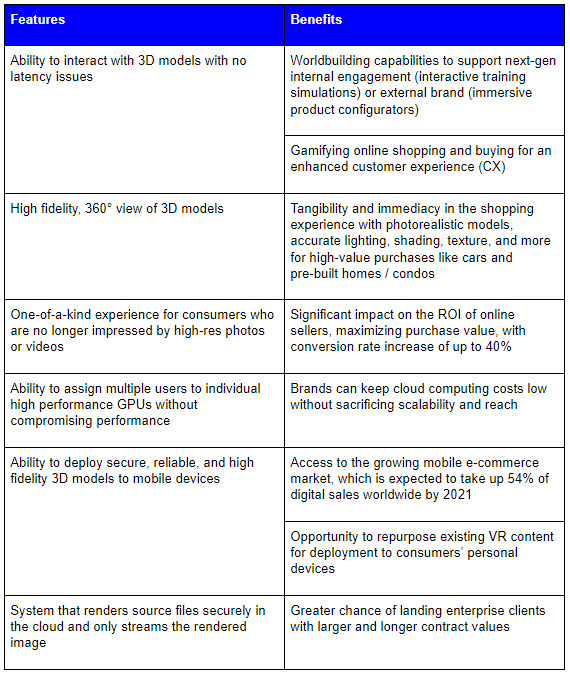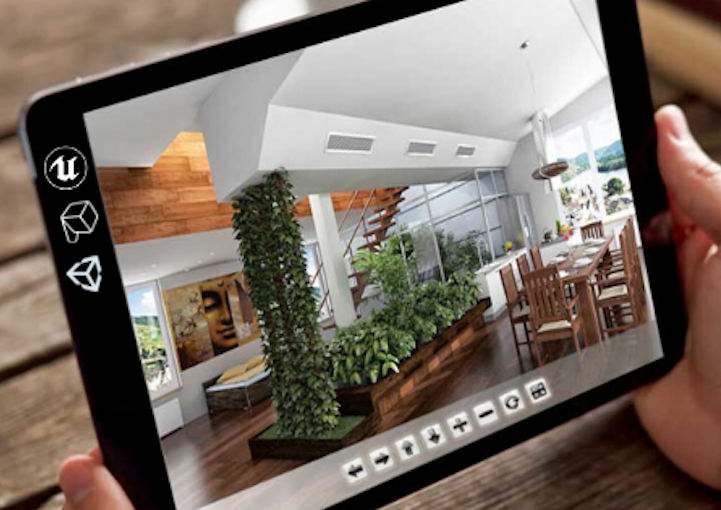INSTANT ON NOW AVAILABLE - Experience Time to first frame as quick as 2 SECONDS
8 Value Propositions for Studios Pitching Cloud-Scale Streaming of Interactive 3D to Clients

There’s a structural change happening in the advertising world. Marketing budgets may be going up, but brands are allocating fewer dollars to ad spend. Instead, brands are redirecting their marketing funds to a more interesting line item: the customer experience.
The result? The world’s biggest advertisers are working with fewer agencies. The good news is this means brands are looking for agencies who can help them design high impact advertising campaigns and digital experiences focused on customer engagement and relationship building.
Real-time 3D experiences offer creative agencies a way to stand out and win business from brands eager for one-of-a-kind marketing campaigns. Brands can engage in the kind of world building needed for effective storytelling.
Companies interested in this kind of experience, like car makers, architectural firms, and even corporate training departments, can use ultra-realistic 3D experiences to deliver the immediacy of the physical world through the convenience of digital channels.
That said, it can be a hard sell for business leaders who aren’t familiar with the intricacies of cloud computing and deploying interactive 3D models. Linking the features of interactive, photorealistic 3D visualization directly to benefits is essential.

Worldbuilding capabilities for enhanced corporate training or immersive e-commerce
Brands can function as a means of “consumer self-expression”. Consumers seek products that they believe converge with their identity. At the same time, they explore their own identity through a brand’s messaging.
Case in point: An automaker positions itself as the car for adventurers - and aspiring adventurers buy that car in response. unre
This notion of identity is especially impactful when it comes to making high-value purchases like vehicles or homes.
Related Read: How Unreal Engine is creating new possibilities for the automotive industry
In the corporate world, trainers need worldbuilding to create alternate realities where employees can practice under different conditions through various simulations. An oil worker learns how to do their job under extreme weather conditions. A retailer learns how to manage tense customer interactions or a store emergency. A surgeon learns how to use a new medical device.
In both the e-commerce brand experience and corporate training context, interactive 3D streaming presents a compelling use case. But your creative agency’s pitch is not just about offering cool, hi-res 3D models. For these use cases, interactivity and configurability is essential.
Brands and corporate trainers need the ability to tweak or transform their existing 3D world either for a new campaign or different training module. Existing deployment methods, like WebGL, are sufficient for simple 3D models that exist in isolation like apparel product catalogs.
For companies that require interactive world building with ultra-realistic models and/or complex computations processed in real time, an end-to-end interactive 3D streaming platform, where all user engagements are rendered in the cloud, is integral to a scalable and manageable solution.
Read Next: 6 main challenges with interactive 3D (and how your company can solve them)
With a cloud streaming platform like PureWeb, creative agencies can quickly and easily deploy and deliver immersive 3D experiences that engage both employees or customers in a timely manner.
Gamify the online research (and buying) experience for an enhanced digital experience
Brick-and-mortar stores are doubling down on their competitive advantage: the ability to offer an in-person experience. But just because these retailers have physical locations, doesn’t mean they have a monopoly on interactivity.
One survey found that 87 percent of retailers intended to use gamification to engage customers over the next five years – and for good reason.
Gamifying the shopping experience is one way to introduce a sense of time (or urgency), space, and emotional investment. All of these factors contribute to a greater feeling of customer loyalty. Shoppers can participate in games or activities online and earn points or badges. These points and badges in turn lead to free offers or discounts.
While these games can mimic traditional mobile games, they risk getting lost among more popular apps. On the other hand, interactive 3D streaming gives brand executives a way to amp up their personal game offerings with ultra-realistic graphics and interactive experiences like building their favorite products in real time, which can elevate the gaming experience.
And since interactive 3D cloud streaming works as reliably on consumer-grade smartphones as it does on a desktop computer, customers can easily access the experience.
Accurately display lighting, shading, and texture for high value purchases
Photo galleries may work for purchases like clothing or fast moving consumer goods like toiletries, but they don’t offer the tangibility and immediacy consumers expect when buying high-value items like jewelry, cars, motorbikes, or condos.
Why does this matter? Because high-value items are the next big growth opportunity in e-commerce. They also offer a way for online retailers to compete against seemingly unbeatable giants like Amazon since most consumers don’t turn to third-party marketplaces for luxury goods. What’s more, luxury brands aren’t racing to place them there. As LVMH’s finance chief bluntly put it in 2016, “The existing business of Amazon doesn’t fit with luxury, full stop”.
In other words, brand managers and customers alike expect a more heightened, white glove shopping experience when they’re dropping thousands of dollars on a luxury ride, vacation home, or designer purse. Being listed next to photos of cat food and shovels is a non-starter.
Interactive 3D models provide an alternative to this. For starters, they cultivate a shopping experience that closely mimics the in-store experience with the ability to zoom in and analyze the item’s texture. Consumers can also rotate items to see how the light hits it at different angles.
Plus, 3D world building allows retailers to put items in context by placing jewelry on 3D models or place cars and motorbikes in ultra-realistic urban or camping environments. Property developers can design interactive, gamified home buying experiences that allow customers to inhabit their dream home and use 3D tools to build explore upgrades like hardwood flooring or tile countertops.
Measure ROI of up to 40% thanks to an impactful customer acquisition medium
The rapid growth of e-commerce and its accessibility have brought ample opportunities for new and established brands over the past several years. But even a decade ago, observers were skeptical about how long e-commerce would grow at the expense of brick-and-mortar stores. As the Financial Times put it in 2010, “the ecommerce gravy train is facing its own challenges.”
What challenges exactly? Increased competition in the form of easy market entry, market dominance by massive players like Amazon, Walmart, Alibaba, and JD.com, and of course, slowing growth (which had to happen eventually).
ICYMI: How to build the ultimate digital marketing campaign for your 3D configurator
As areas like North America and Europe reach internet penetration rates of nearly 100 percent, e-commerce growth will rely more on factors like lead generation and profit margins rather than new customer volume.
In other words, sellers need to beef up their top of funnel numbers, which means creating more compelling content. And once they’ve got a digital shopper’s attention, they need to hold it to boost conversion rates. Interactive visualization presents this opportunity for online marketers and sellers.
And this applies across industries.
Consider the average conversion rates for standard PPC ads in areas like the automotive industry (6 percent), real estate (2.47 percent), and home goods (2.7 percent). By comparison, companies using 3D product configurators / visualizers have experienced conversion rates up to 40 percent higher than traditional online methods.
Ability for brands to keep cloud computing costs low without sacrificing scalability and reach
A well-designed, interactive 3D cloud streaming experience attracts attention. But if the experience isn’t built for scalability, a marketing campaign’s success can quickly become its downfall as the people at Chevy learned the hard way during the launch of their Unreal Engine created Corvette visualizer.
When presenting the potential of an interactive 3D experience streamed through the cloud, creative agencies will need to answer tough questions about the cost. Will a global campaign with the potential for millions of users lead to outrageous cloud computing costs? How will the brand be able to efficiently manage its cloud usage while ensuring access to its entire audience?
PureWeb’s interactive 3D cloud streaming platform is built to prevent this issue. Our multi-tenant cloud infrastructure is designed to deploy multiple concurrent users to the same high performance GPUs in the cloud.
Read Next: 6 reasons why PureWeb is the most powerful streaming platform for real-time 3D
In other words, 3D models are still high fidelity and the experience remains up and running, but the costs don’t go through the roof.
In numbers, assigning more than one user to a server at the same time enables brands to cut costs by 50 percent or more, depending on the size of the model.
Consider the average cost per action by industry for traditional media advertising:
- Automotive industry: $33.52
- Real estate industry: $116.61
- Home goods: $87.13
By comparison, the average cost per user engagement for an interactive 3D application is $0.40 for an average 5 minute engagement with an online configurator. And as discussed earlier, conversion rates on interactive top-of-funnel content is significantly higher than the conversion rate for digital ads, making real-time 3D experiences a no brainer for brands.
Distribute your VR content further with real-time 3D cloud streaming experiences
VR has become the go-to modality for interactive 3D experiences, but this channel does have its limitations.
VR is an expensive solution that can cost tens of thousands of dollars. Despite, it doesn’t necessarily eliminate travel costs since employees often travel to dedicated VR training centers. What’s more, anywhere from 40 to 70 percent of users experience motion sickness while using VR headsets.
The good news is that the expensive content distributed through VR headsets can be repurposed and distributed further through an interactive 3D cloud streaming platform. This allows your clients’ marketing teams to squeeze more value out of their initial investment by distributing 3D content to mobile devices and tablets. Moreover, your creative agency can generate additional revenue by assisting with the re-deployment of content through a 3D streaming platform.
In addition, a fully-managed platform makes it easy for corporate training developers to integrate their training simulation modules into existing learning management systems (LMS). Companies avoid creating a fragmented training experience, and employees benefit from all the features of their existing learning management system including mobile access and gamification elements.
Seize the lucrative, high growth mobile e-Commerce market with a reliable real-time 3D web distribution system
Today, more people shop online using a smartphone or tablet than they do in physical stores. Why? Because it’s more convenient and customers say it’s easier to compare prices while shopping from their device.
Consumers consider their smartphone an “extension” of their hand. Since interactive 3D streaming is designed to work easily on any mobile browser (thanks to only streaming the rendered images), retailers can amp up their mobile shopping experience without compromising on quality.
As we mentioned earlier, interactive 3D tools provide a way to soothe anxieties around online shopping for high value purchases. With PureWeb’s architecture, other industries like the auto and constructions industries can create an omnichannel marketing strategy by distributing their photorealistic and interactive car / home buying experiences to any web browser on any consumer device.
Greater chance of landing enterprise clients with larger and longer contract values
Finally, a strong real-time 3D cloud streaming platform like PureWeb provides enterprise-level security. At the beginning of this article, we discussed how brands are reducing the number of agencies they work with. This means that creative digital agencies will need to be even more impressive during the RFP process, not just in terms of their creative capabilities but their larger capacity to service enterprises.
More on Training Simulation: How companies can deliver training simulations to any employee device
Understanding how to address the data governance requirements of big companies is a smart way for creative agencies to stand out from the pack. Familiarity with both interactive 3D cloud streaming and a platform that offers this securely gives creative agencies a competitive advantage.
Interactive 3D Experiences make brands memorable in an online sea of forgettable content
Above all, interactive 3D experiences help brands stick in the minds of consumers. In the past, sleek ads, copy, and jingles allowed brands to claim a portion of consumers’ mental real estate. Today, these elements get lost in a sea of other content trying to sell something.
On the other hand, interactive 3D content providing the most pixel-perfect resolution possible, offers immediate value to consumers in the form of memorable, immersive experiences - experiences that are more likely to end in a sale.


